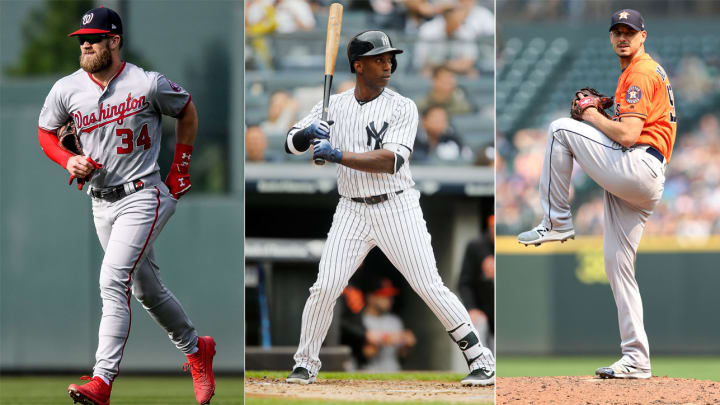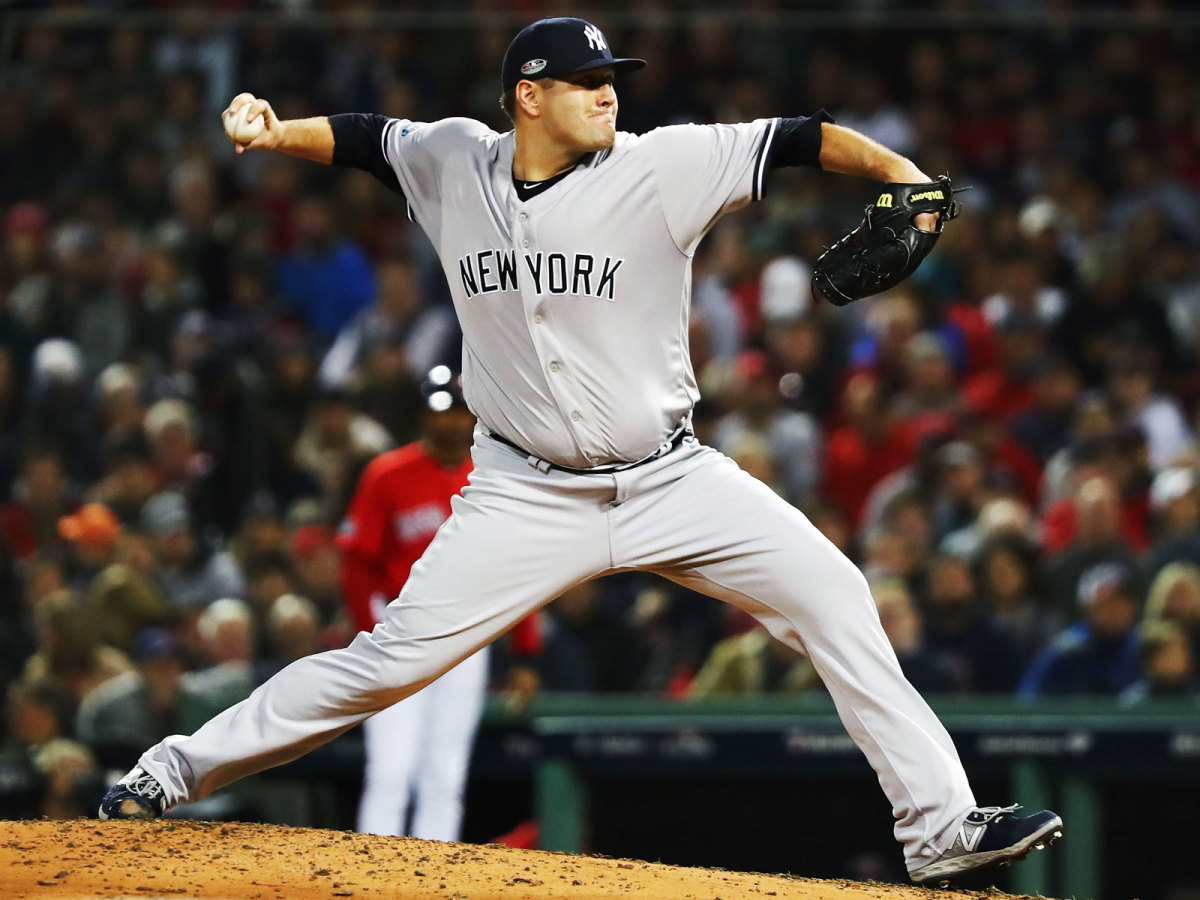Winter Meetings Recap: Bryce Harper Lays Low, MLB Can't Promote and the Rays Make a Splash

LAS VEGAS — It was only two years ago that people immediately declared the White Sox the “winners” of the winter meetings because they acquired prospects with heavy buzz, including Yoan Moncada, Michael Kopech, Lucas Giolito and Reynaldo Lopez. Moncado is a .234 hitter who has fanned in 34 percent of his plate appearances, Kopech blew out his elbow, Giolito posted a 6.13 ERA this year, Lopez has a 4.21 ERA in 51 career games, and the White Sox have lost 195 games and 130,000 paid customers in the two seasons since.
Nobody’s giving up on them, but maybe we should give up on the whole “winners and losers” thing as instant judgment of the winter meetings. This time, as baseball is leaving Las Vegas after yet another hum-drum winter meetings, let’s try this: here’s what we learned from these meetings:
1. Manny Machado will go on tour, Bryce Harper will not.
Neither one of the two marquee free agents is signing any time soon. Machado wants to visit the teams interested in signing him. Scott Boras, the agent for Harper, said his client will not do so. Teams have and will meet with Harper in either Las Vegas or Los Angeles.
The Phillies, White Sox and Nationals still look like the top landing spots for Harper, and Philadelphia and the Yankees for Machado. Washington didn’t exactly slam the door closed on Harper, and if he circles back to them late in the game and expresses a desire to come back, are they really going to say, “No, thanks”? But remember, the Nationals love deferring money in big contracts (Max Scherzer, Stephen Strasburg, etc.) and one source said their $300 million offer to Harper deferred as much as $100 million, bringing down the true value significantly.
2. Baseball is poor at promoting itself.
Baseball once defined the pizzazz and glamor of free agency, winning headlines and chatter in its offseason with not just player movement but especially the talk of player movement. Now the NFL and NBA have eclipsed baseball when it comes to generating free agent buzz, and a new kind of “gag order” at these winter meetings showed why baseball is missing out.
Cardinals general manager Michael Gersch and Reds general manager Nick Kroll shocked me when, after I asked them about free agents, each gave the same version of “You know I can’t talk about free agents.”
What?
I always knew executives were not supposed to talk about players under contract to other teams, but now they can’t even talk about players who are not on any team’s roster?
TAYLER: What to Make of the Edwin Encarnacion-Carlos Santana Three-Team Swap?
It turns out, unfortunately, that is partly true. The players association monitors all public comments by executives. In keeping with the poor climate between clubs and the union, it is vigorously enforcing Attachment 49 of the CBA, which holds that clubs may not “disclose to the media the substance of contract discussions between a player and a club,” which includes the wide berth of “decisions not to make offers or to withdraw offers.”
That is the provision Boras invoked when Nationals owner Mark Lerner revealed the club had told Harper of their offer, “This is the best we can do.”
The provision does allow clubs to answer direct questions from the media about interest in free agents without specifics, but executives have decided it’s not worth the hassle to say anything about free agents. Here’s what happens if a club executive says something even remotely interesting about a free agent: the union notifies MLB about a concern about the comment and then MLB has to research the context and substance of the comment and, if needed, remind the executive of the parameters.
On Tuesday, for example, Yankees GM Brian Cashman openly discussed Harper with reporters, telling them he already had enough outfielders and he did not regard Harper as a possible first baseman. It was an interesting bit of candor that got people talking. It was good buzz. The very next day he appeared to backtrack, saying “we are prepared to pivot and react if things change.”
People took that to mean the Yankees were now in on Harper. More likely, it was another case of Attachment 49 paranoia.
Think about what is going on here: baseball intentionally is squelching buzz on free agency. And to add to the nonsensical non-promotion of the game, MLB actually housed the GMs and their staffs in a separate, secure hotel apart from the actual meetings. In terms of winter meetings access – which helps promote the game - we have gone from GMs working the lobby, to GMs occasionally passing through the lobby on their way to meetings, to now GMs bunkered in a secured, separate hotel, apart from the media and meetings attendees.
3. The Phillies overpaid for Andrew McCutchen, but …
McCutchen can still turn around anybody’s fastball, but his numbers against breaking pitches have been dropping steadily. Last season he was the 10th worst hitter in baseball against breaking pitches (.189) among those with 150 results. His defense is average, though that makes him an upgrade on Rhys Hoskins in leftfield. The Phillies bought his age 32, 33 and 34 seasons for $50 million, a risk given today’s bias against aging players.
But McCutchen has been durable, has maintained his running speed and – here’s the key – is exactly the kind of professional this team needed in an everyday player. For a young team that collapsed down the stretch last year, McCutchen will help.
4. The Reds are a mystery team.
They will pay about $10 million for Tanner Roark to pitch 180 average-at-best innings (4.50 ERA over his past 63 games), something an actual contender, Washington, wanted no part of. The Reds have been connected to Yasiel Puig, Alex Wood, Dallas Keuchel, Sonny Gray, J.T. Realmuto, A.J. Pollock and have no true centerfielder. For a team still in a bad place on the winning curve, their plan is not yet apparent.

5. Lance Lynn is a mystery pitcher.
Coming off a 3.43 ERA in 2017, Lynn couldn’t find a job until late in the off-season, and when he did he settled on a one-year deal. He then threw fewer innings with a much worse ERA (4.77) - and got rewarded with a three-year contract with Texas early in the offseason. It’s the early clubhouse leader for most puzzling contract of the winter. Give him this: he provides cromulent innings, averaging 183 of them over six seasons when he’s been healthy. Lynn, Roark, Ivan Nova … I’m not sure why teams not ready to win are paying $10 million for mediocrity when they should have a combination of young pitchers who can cover 30 starts.
6. The market is strong (for now).
The contracts for Morton, McCutchen and Lynn, as well as those out of a crowded reliever market (Jeurys Familia and Joe Kelly) are at or above market value and the pace of signings is fine. It’s early, but the slowdown from last year that panicked the union doesn’t seem to be repeating itself, though the Machaco, Harper and Craig Kimbrel contracts will tell us more.
7. The Rays are a legitimate contender.
Tampa Bay made one of the shrewdest signings in getting pitcher Charlie Morton on a two-year deal. Even before the Rays signed Morton, one evaluator told me Tampa Bay “has more high-end arms in the majors and in their system than any team in baseball.” Morton’s filthy stuff adds to that cache.
TAYLER: Young Managers Are the New Fad
Now they shouldn’t stop. They would have been better off also splurging on Edwin Encarnacion in that three-way deal with Cleveland and Seattle. Encarnacion is one of only two players with 30 homers and 100 RBI in each of the past four years. The other is Nolan Arenado. Now the Rays need to go get Nelson Cruz, the veteran bat they need to take advantage of this window to win.
8. We had an Elvis sighting.
It’s Vegas, so why shouldn’t the Blue Jays select a pitcher named Elvis Luciano in the Rule 5 draft? But here’s the really cool part: Luciano is only 18 years old, the youngest Rule 5 pick I ever remember. He was originally signed by Arizona at 16 years old, but flunked his physical and had his contract voided. The Diamondbacks then re-signed him to a smaller bonus, but in doing so the revised contract created a technicality that made him eligible for the Rule 5 draft. Kansas City acquired Luciano in June in the trade that sent John Jay to Arizona.
Luciano has never pitched above Rookie ball. Per Rule 5 rules, Toronto must keep him on its major league roster the entire season or offer him back to Kansas City. That’s a big ask. Luciano turns 19 in February. How unusual would it be for Toronto to keep a pitcher that young on its major league roster all year? Luciano will be 19 years, 41 days old on Opening Day. Nobody that young has pitched in a big league game since 1984, when Jose Rijo did so for the Yankees.
